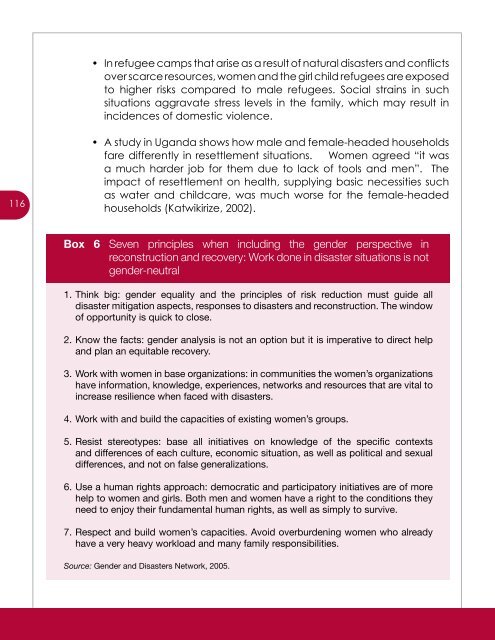GGCA Gender and Climate Change Training Manual - Women's ...
GGCA Gender and Climate Change Training Manual - Women's ...
GGCA Gender and Climate Change Training Manual - Women's ...
Create successful ePaper yourself
Turn your PDF publications into a flip-book with our unique Google optimized e-Paper software.
• In refugee camps that arise as a result of natural disasters <strong>and</strong> conflicts<br />
over scarce resources, women <strong>and</strong> the girl child refugees are exposed<br />
to higher risks compared to male refugees. Social strains in such<br />
situations aggravate stress levels in the family, which may result in<br />
incidences of domestic violence.<br />
116<br />
• A study in Ug<strong>and</strong>a shows how male <strong>and</strong> female-headed households<br />
fare differently in resettlement situations. Women agreed “it was<br />
a much harder job for them due to lack of tools <strong>and</strong> men”. The<br />
impact of resettlement on health, supplying basic necessities such<br />
as water <strong>and</strong> childcare, was much worse for the female-headed<br />
households (Katwikirize, 2002).<br />
Box 6 Seven principles when including the gender perspective in<br />
reconstruction <strong>and</strong> recovery: Work done in disaster situations is not<br />
gender-neutral<br />
1. Think big: gender equality <strong>and</strong> the principles of risk reduction must guide all<br />
disaster mitigation aspects, responses to disasters <strong>and</strong> reconstruction. The window<br />
of opportunity is quick to close.<br />
2. Know the facts: gender analysis is not an option but it is imperative to direct help<br />
<strong>and</strong> plan an equitable recovery.<br />
3. Work with women in base organizations: in communities the women’s organizations<br />
have information, knowledge, experiences, networks <strong>and</strong> resources that are vital to<br />
increase resilience when faced with disasters.<br />
4. Work with <strong>and</strong> build the capacities of existing women’s groups.<br />
5. Resist stereotypes: base all initiatives on knowledge of the specific contexts<br />
<strong>and</strong> differences of each culture, economic situation, as well as political <strong>and</strong> sexual<br />
differences, <strong>and</strong> not on false generalizations.<br />
6. Use a human rights approach: democratic <strong>and</strong> participatory initiatives are of more<br />
help to women <strong>and</strong> girls. Both men <strong>and</strong> women have a right to the conditions they<br />
need to enjoy their fundamental human rights, as well as simply to survive.<br />
7. Respect <strong>and</strong> build women’s capacities. Avoid overburdening women who already<br />
have a very heavy workload <strong>and</strong> many family responsibilities.<br />
Source: <strong>Gender</strong> <strong>and</strong> Disasters Network, 2005.

















